In this Article...
Selecting objects is one of the basic tools you should know. You will use it a lot. You may need to select many objects at once. Or probably all objects in the same category.
I see in one of my training class, the students are struggling with this. So I thought it would be useful if I share this here. You probably will find it useful as well.
Noun verb selection vs. verb noun selection
Revit allows you to select object first then activate a modify command. This is called noun verb selection. Whenever you select object first, Revit will open contextual tab: modify. You don’t have to change to ribbon tab to modify first.
Revit also allows you to initiate the command first, then select the objects. To end object selection, press ENTER or SPACE. This is called verb noun selection. This is probably preferred for shortcut users. If you don’t know the modify command shortcut, you will need to switch to modify tab first.
Both work the same way.
Remember: For noun verb selection, you need to activate modify tool before selecting objects.
Now let’s see how we can select objects in Revit.
1. The basic: Clicking the objects
The most basic method is by clicking object you want to select. Move your pointer above an object. When it’s highlighted, click you mouse button.
If you want to add more objects to your selection, hold CTRL key. You will see (+) sign near your cursor. Click to select more objects.
If you want to remove objects from your selection, hold SHIFT key. (–) sign will appear near your cursor. Click selected object to remove it from selection.
2. When it gets crowded: Cycle between objects
When you have quite a lot of objects, you will see your objects are overlapping. You can cycle between overlapping objects by pressing TAB key. After you see the object you want highlighted, click your mouse.
Hint:
Press TAB slowly, especially if you are new with this. Not only see the highlighted elements in your view, watch the status bar (or tooltips) to see if the highlighted object is correct.
3. To select many: Drag a window selection
You can also select many objects at once by dragging a window selection. When modify tool is active, click and hold your left mouse button. Make a window selection then release the button. Simple.
One thing you should know though:
When you create the window selection from left to right, we call it window selection. You can see the window as continuous line.
When you create the window selection from right to left, we call it crossing window selection. The window is shown as dashed line.
|
|
|
| Window selection | Crossing window selection |
Window selection will select objects that lies completely inside the rectangle. If only some part of the object is inside the rectangle, then it will not be selected.
Crossing window polygon will select objects inside and touching the selection window.
4. To select many in a category: Filter selection
You can use window selection to select many objects at once. But this is usually useless. By using window selection, you select every object within the window. Mostly we need to modify objects in the same category or the same family.
You can filter objects from your selection by using selection filter. You can combine filter with selection window. After you select objects, you will see modify contextual tab. Click filter in selection panel.
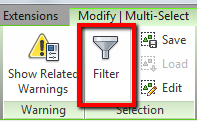
The opened dialog box will show you all category in your selection. You can uncheck what you want to exclude from selection. Or you can click Check None, then choose only categories you want to select.
Click OK to apply filter.
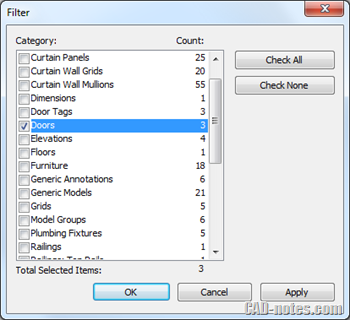
5. To select many with the same family and types
Using filter is very helpful. However, It selects all objects in the same category. It means it will select all doors regardless the family name and type.
You might need to choose only objects with the same family and type. You can use contextual menu to do that.
Using contextual menu in view
Contextual menu for selecting similar object is available in view. Select the object in view then right click.
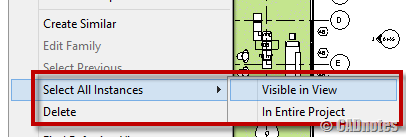
Using contextual menu in project browser
You can also select objects by family name and type from project browser. Expand families group, then find the type you want to select. Right click, then choose from select all instances. This is very useful if you know the family type, but you don’t know where they’re placed.
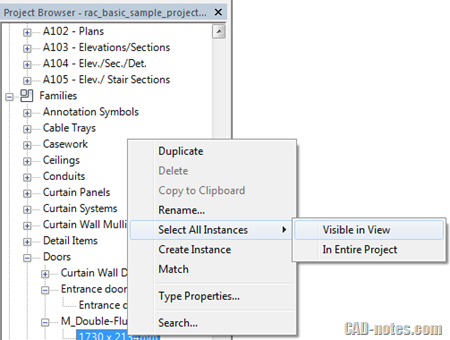
6. To reselect previous selection
If you need to reselect the same objects after doing an action. You don’t have to pick the objects, using window selection or filter to select them again.
Simply press Ctrl + Left Arrow on your keyboard. Or you can right click your mouse and click select previous from contextual menu.
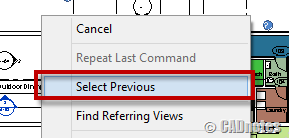
7. To save and load your selection
Select previous is useful if you want to reselect object immediately. But if you need to reselect some objects repeatedly during your design, you need to save your selection.
You can save your selection by clicking save in selection panel, modify contextual tab.
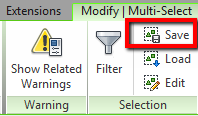
To load your selection, you can use load button from Manage tab> Selection panel. You can also edit your saved selection later.
To sum up
Selecting objects is very important in Revit. You will need to copy objects, erase, or change the object’s properties.
When you have complex design, you will need to know all the selection method to make it easier.
Do you have your favorite method? Do you have any experience when selecting objects you want to share?
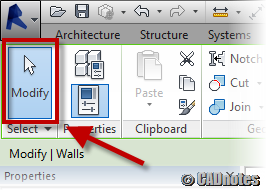
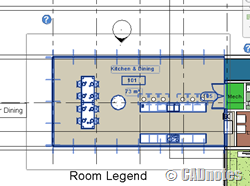
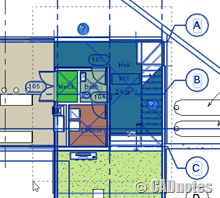




Hi! may be you know, how i can select several elements by frame, such as generetic models and space separation lines?
I’m not sure if I understand the question. Can you elaborate or provide some images? You can send the image by sending message on our facebook page here. Or upload it on dropbox, instagram, etc. and share the link here.
Revit, objects are not lining up and appear to move when zooming in. Objects look as though they are not connected and when I try to pick lines I often need to select well away from the line to pick it up. Could it be a problem of the graphis card?
It sounds like a graphic card issue. Have you tried to update the driver or turn off the hardware acceleration?
Thanks to you.
Hi Edwin
first…your articles are becoming more and more useful to me, thank you for your hard work
my query is…is there a way of simply making a temporary reference plane…if for example you want to flip to a side view of something that you are working on in plan.
it seems like a really involved process to go to the reference plane tool and do all of the procedure to finally arrive at what you want…and if you need to make several changes at different planes??…it takes too long.
What you want to do is to select the object and somehow automatically make a "temporary" reference plane.
any thoughts on this ..or is this a newbie query that I just haven't found the technique of yet?